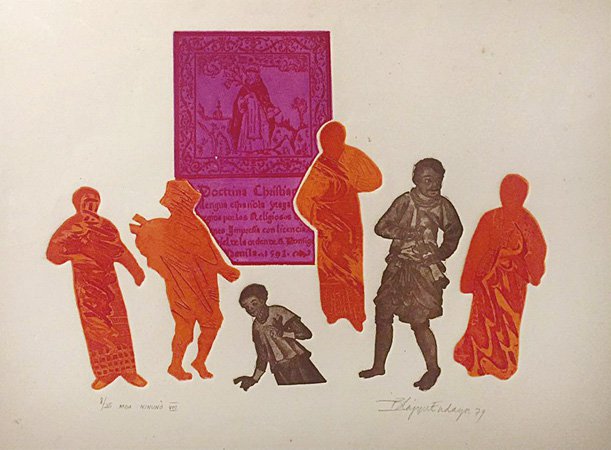Cultural Center of the Philippines
ENCYCLOPEDIA OF
PHILIPPINE ART
Mga Ninuno VIII
(Ancestors VIII) / 1976-79 / Etchings, mixed media, serigraphs / 27.94 x 38.10 cm / Artist: Imelda Cajipe-Endaya / Private collection
In her Mga Ninuno series, Cajipe-Endaya deals with the theme of national identity in a historical context. Her explorations of images of the Filipino draw from such sources as the Boxer Codex, circa 1590, the Doctrina Christiana en Lengua Española y Tagala (The Christian Doctrine in the Spanish and Tagalog Languages), 1593, and turn-of-the century photographs. These archetypal images are cut out and arranged in a composition by means of photo-transfer technology on the print surface. At times, she crops or cuts up the human figures to emphasize their two-dimensionality, which they have in common with traditional Asian art. She may also treat them as silhouettes, which she prints or scribbles on with random design to imply various contents.
The artist eschews any suggestion of perspective in depth by spreading them on the print at all angles and positions. To foreground design and texture and to enhance the flatness of the surface as print/text, she incorporates fragments of texts in old Tagalog orthography as well as gestural scribbles. The texts, printed in the xylographic method of the early engravings, have an aesthetic value while they also provide a historical context. The various figures of the inhabitants of the Philippines in the precolonial and Spanish colonial periods do not only show the variety of costumes but also imply cultural colonization along with class stratification within the colonial order. The relations of the figures pose questions of identity and of illusion versus reality, or sometimes assume the character of mirror images, which suggest self-consciousness in the tensions arising from the encounter between indigenous culture and the colonizing project.
Written by Alice G. Guillermo
